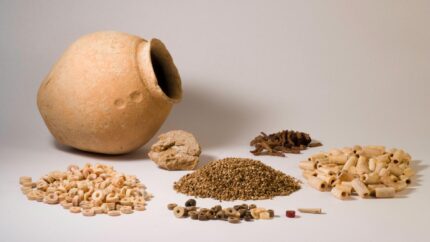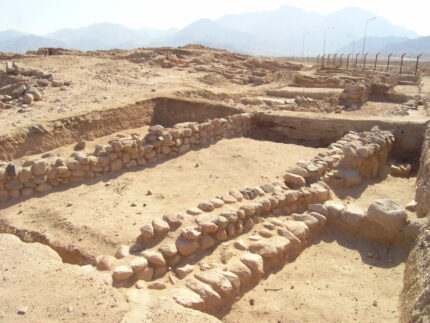 A pot unearthed at the Chalcolithic settlement in Tell Hujayrat al-Ghuzlan in Jordan has been discovered to contain thousands of beads made of clay, bone and shell. It dates to approximately 3600 B.C.
A pot unearthed at the Chalcolithic settlement in Tell Hujayrat al-Ghuzlan in Jordan has been discovered to contain thousands of beads made of clay, bone and shell. It dates to approximately 3600 B.C.
The initial find was made in 2010. Archaeologists from the Orient Department of the German Archaeological Institute (DAI) and the Institute of Archeology at the University of Jordan (Amman) dug down to find the lowest layer of the buildings in the settlement. In a room at the lowest level of a home, they found a small round clay pot that was intact and still sealed with a clay plug. It rattled when archaeologist Jens Notroff lifted it.
The pot was cleaned and documented and when the stopper was removed, the pot was revealed to be full of tiny objects. They each had to be removed and cleaned.
In the end, the contents of the jar turned out to be a treasure of beads made from bones and shells. Among the pearls were thousands of tiny pearls, all pierced and polished. “Just cutting and polishing these beads took a lot of work time. Their size was in the millimeter range. Others were larger, also elongated in shape,” says Notroff.
What exactly this discovery is all about still puzzles scientists to this day. The type of beads was known, for example as jewelry and garment decoration, but the location and the mass were unparalleled. “I could imagine that this was a kind of start-up depot,” says Notroff – i.e. a kind of lucky charm that was built in. “The niche seemed to have been precisely prepared for this dumping.” The elaborately produced filling of the jug represented a high value.
The findings in the neighboring room also suggest that it must have been a special building. Here, depictions of animals were discovered on the back wall of the site, which were pressed into the still wet clay of the wall with the fingers. Ibexes and predators can be recognized as dotted hole drawings. In the backfilling of the room, the archaeologists also discovered numerous ibex horns and large layers of ash. It could be that the building was destroyed in a fire.
 Located 2.5 miles north of Aqaba, Tell Hujayrat al-Ghuzlan was a fortified settlement inhabited between 4,000 and 3,500 B.C. Structures with a mixture of stone boulder walls and mud brick walls have been found there, with evidence they were reinforced after suffering damage in an earthquake. It was destroyed and abandoned when another earthquake struck, but unlike many of the other tells in the region, it was not razed to the ground or built over after the fatal seismic event. The remains of the labyrinthine floor plan of the settlement survive, with walls up to 18 feet high preserved complete with original plastering, windows, doorways and the pillars that supported the roofs.
Located 2.5 miles north of Aqaba, Tell Hujayrat al-Ghuzlan was a fortified settlement inhabited between 4,000 and 3,500 B.C. Structures with a mixture of stone boulder walls and mud brick walls have been found there, with evidence they were reinforced after suffering damage in an earthquake. It was destroyed and abandoned when another earthquake struck, but unlike many of the other tells in the region, it was not razed to the ground or built over after the fatal seismic event. The remains of the labyrinthine floor plan of the settlement survive, with walls up to 18 feet high preserved complete with original plastering, windows, doorways and the pillars that supported the roofs.
This extraordinary level of preservation and relatively short span of occupation gives archaeologists a unique opportunity to examine a Chalcolithic settlement from the 4th millennium as the Copper Age transitioned to the Bronze Age. This is the period when the smelting of copper first appears on the archaeological record.
For the beginning of the Bronze Age, Tell Hujayrat al-Ghuzlan and its neighboring town were not only an important production site for copper, but also an important trading hub near the Red Sea between the Levant and Egypt. The mystery of the pearl jar is still waiting to be finally deciphered: the discovery site is currently being further evaluated at the DAI’s Oriental Department.